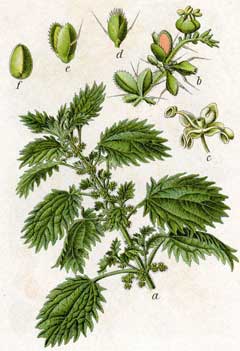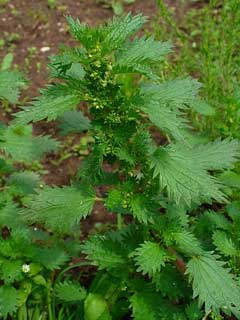 |
|
commons.wikimedia.org/wiki/File:Urtica_urens_Sturm40.jpg |
 |
| commons.wikimedia.org/wiki/User:Llez |
Translate this page:
Summary
Physical Characteristics

 Urtica_urens is a ANNUAL growing to 0.6 m (2ft).
Urtica_urens is a ANNUAL growing to 0.6 m (2ft).
It is not frost tender. It is in flower from June to September, and the seeds ripen from July to October. The species is monoecious (individual flowers are either male or female, but both sexes can be found on the same plant) and is pollinated by Wind. The plant is not self-fertile.
Suitable for: light (sandy), medium (loamy) and heavy (clay) soils. Suitable pH: mildly acid, neutral and basic (mildly alkaline) soils. It cannot grow in the shade. It prefers moist soil.
UK Hardiness Map
US Hardiness Map
Synonyms
Plant Habitats
Edible Uses
Young leaves - cooked and used as a potherb[1, 9, 12, 46, 105, 183]. A very nutritious food, high in vitamins and minerals, it makes an excellent spinach substitute and can also be added to soups and stews. Only use the young leaves and wear stout gloves when harvesting them to prevent getting stung. Although the fresh leaves have stinging hairs, thoroughly drying or cooking them destroys these hairs. Nettle beer is brewed from the young shoots[200].
References More on Edible Uses
Medicinal Uses
Plants For A Future can not take any responsibility for any adverse effects from the use of plants. Always seek advice from a professional before using a plant medicinally.
Nettles have a long history of use in the home as a herbal remedy. A tea made from the leaves has traditionally been used as a tonic and blood purifier. The whole plant is antiasthmatic, antidandruff, astringent, depurative, diuretic, galactogogue, haemostatic, hypoglycaemic and a stimulating tonic[4, 9, 21, 36, 165, 238]. An infusion of the plant is very valuable in stemming internal bleeding[4], it is also used to treat anaemia, excessive menstruation, haemorrhoids, arthritis, rheumatism and skin complaints, especially eczema[238]. Externally, the plant is used to treat arthritic pain, gout, sciatica, neuralgia, haemorrhoids, hair problems etc[238]. For medicinal purposes, the plant is best harvested in May or June as it is coming into flower and dried for later use[4, 238]. This species merits further study for possible uses against kidney and urinary system ailments[222]. The juice of the nettle can be used as an antidote to stings from the leaves and an infusion of the fresh leaves is healing and soothing as a lotion for burns[4]. A homeopathic remedy is made from the fresh plant, gathered when in flower[232]. A useful first-aid remedy, it is used in the treatment of ailments such as bites and stings, burns, hives and breast feeding problems[232].
References More on Medicinal Uses
The Bookshop: Edible Plant Books
Our Latest books on Perennial Plants For Food Forests and Permaculture Gardens in paperback or digital formats.

Edible Tropical Plants
Food Forest Plants for Hotter Conditions: 250+ Plants For Tropical Food Forests & Permaculture Gardens.
More

Edible Temperate Plants
Plants for Your Food Forest: 500 Plants for Temperate Food Forests & Permaculture Gardens.
More

More Books
PFAF have eight books available in paperback and digital formats. Browse the shop for more information.
Shop Now
Other Uses
A strong flax-like fibre is obtained from the stems[200]. Used for string and cloth[1, 4, 6, 13, 36], it also makes a good quality paper[115]. It is harvested as the plant begins to die down in early autumn[99]. An essential ingredient of 'QR' herbal compost activator[32], the leaves are also an excellent addition to the compost heap[12, 18, 20] and they can be soaked for 7 - 21 days in water to make a very nutritious liquid feed for plants[54]. This liquid feed is both insect repellent and a good foliar feed[14, 18, 53]. The growing plant increases the essential oil content of other nearby plants, thus making them more resistant to insect pests[18, 20, 54]. A hair wash is made from the infused leaves and this is used as a tonic and antidandruff treatment[172]. A green dye is obtained from the leaves and stems[4, 115, 232]. A yellow dye is obtained from the root[115, 232]. An oil extracted from the seeds is used as an illuminant in lamps[232].
Special Uses
References More on Other Uses
Cultivation details
Prefers a nitrogen-rich soil[200]. The best fibre is produced when plants are grown on deep fertile soils[200]. Dislikes shade[17].
References Carbon Farming Information and Carbon Sequestration Information
Temperature Converter
Type a value in the Celsius field to convert the value to Fahrenheit:
Fahrenheit:
The PFAF Bookshop
Plants For A Future have a number of books available in paperback and digital form. Book titles include Edible Plants, Edible Perennials, Edible Trees,Edible Shrubs, Woodland Gardening, and Temperate Food Forest Plants. Our new book is Food Forest Plants For Hotter Conditions (Tropical and Sub-Tropical).
Shop Now
Plant Propagation
Seed - sow spring in a cold frame.
Other Names
If available other names are mentioned here
Native Range
Coming Soon
Weed Potential
Right plant wrong place. We are currently updating this section.
Please note that a plant may be invasive in one area but may not in your area so it's worth checking.
Conservation Status
IUCN Red List of Threatened Plants Status :

Growth: S = slow M = medium F = fast. Soil: L = light (sandy) M = medium H = heavy (clay). pH: A = acid N = neutral B = basic (alkaline). Shade: F = full shade S = semi-shade N = no shade. Moisture: D = dry M = Moist We = wet Wa = water.
Now available:
Food Forest Plants for Mediterranean Conditions
350+ Perennial Plants For Mediterranean and Drier Food Forests and Permaculture Gardens.
[Paperback and eBook]
This is the third in Plants For A Future's series of plant guides for food forests tailored to
specific climate zones. Following volumes on temperate and tropical ecosystems, this book focuses
on species suited to Mediterranean conditions—regions with hot, dry summers and cool, wet winters,
often facing the added challenge of climate change.
Read More
Expert comment
Author
L.
Botanical References
17
Links / References
For a list of references used on this page please go here
Readers comment